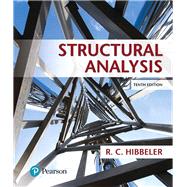NOTE: Before purchasing, check with your instructor to ensure you select the correct ISBN. Several versions of the MyLab™and Mastering™ platforms exist for each title, and registrations are not transferable. To register for and use MyLab or Mastering, you may also need a Course ID, which your instructor will provide.
Used books, rentals, and purchases made outside of Pearson
If purchasing or renting from companies other than Pearson, the access codes for the MyLab platform [[or - the Mastering platform]] may not be included, may be incorrect, or may be previously redeemed. Check with the seller before completing your purchase.
For courses in Structural Analysis; also suitable for individuals planning a career as a structural engineer.
This package includes Mastering Engineering.
Applying theory to structural modeling and analysis
Structural Analysis, 10th Edition, presents the theory and applications of structural analysis as it applies to trusses, beams, and frames. Through its reader-friendly, clear organization, the text emphasizes developing the ability to model and analyze a structure in preparation for professional practice.
The text is designed to ensure those taking their first course in this subject understand some of the more important classical methods of structural analysis, in order to obtain a better understanding of how loads are transmitted through a structure, and how the structure will deform under load. The large number of problems cover realistic situations involving various levels of difficulty.
The updated 10th edition features 30% new problems and an expanded discussion of structural modeling, specifically the importance of modeling a structure so it can be used in computer analysis. Newly added material includes anupdate to the ASCE/SEI 2106 specifications, a discussion of catenary cables, and further clarification for drawing moment and deflection diagrams for beams and frames.
Personalize learning with Mastering Engineering.
Mastering ™ Engineering is an online homework, tutorial, and assessment program designed to work with this text to engage students and improve results. Interactive, self-paced tutorials provide individualized coaching to help students stay on track. With a wide range of activities available, students can actively learn, understand, and retain even the most difficult concepts. The text and Mastering Engineering work together to guide students through engineering concepts with a multi-step approach to problems.
0134679725 / 9780134679723 Structural Analysis Plus MasteringEngineering with Pearson eText -- Access Card Package
Package consists of:
- 0134610679 / 9780134610672 Structural Analysis
- 0134701453 / 9780134701455 MasteringEngineering with Pearson eText -- Standalone Access Card -- for Structural Analysis








